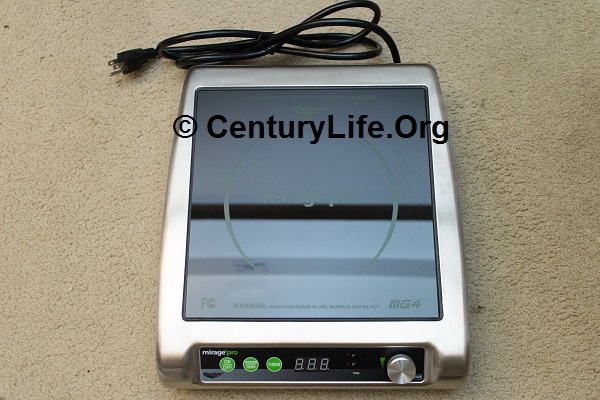
PRODUCT REVIEW
This in-depth product review is for the induction cooker commonly sold in North America as the Vollrath Mirage Pro 59500P (1800 watt).
Background:
The Vollrath company is a privately-held American foodservice (kitchenware and appliance) manufacturer headquartered in Sheboygan, Wisconsin. The company traces its roots back to 1874, when Jacob Vollrath started a factory that made and sold various kitchenware products such as pots and pans. The company also made products as varied as furniture castings and railroad and agricultural parts.
Some of Vollrath’s earliest popular products included ceramic/enamel-coated cast iron and sheet steel, but by the 1930s the company had begun to shift to stainless steel, and the company also mass-produced millions of military products like mess trays and drinking canteens during World War II.
Vollrath expanded, acquired, and divested various businesses after the war, including such major brands as Admiral Craft (AdCraft), Lincoln, and Leyse. Among these acquisitions was the 2009 acquisition of Luxine, a Malibu, California company that developed induction cooking technologies. Vollrath bought the entire company. The result is that Vollrath controls product design, unlike many other brands that basically buy a bunch of pre-built Chinese induction cookers, slap their logos on them, and call it a day. Vollrath has facilities in China for production of the topic of this product review, the Vollrath 59500P Mirage Pro Countertop Induction Range, 14-Inch.
The Good:
Vollrath advertises this induction cooker as 14-inch, but that does not mean that the ceramic top is 14 inches wide. The ceramic square is actually about 11 x 11 inches. (11 inches = 28 cm.) 11 x 11 inches is actually quite roomy, because the part of cookware that touches the bottom is usually much smaller than the top diameter. That’s especially true for skillets (e.g., an 11-inch skillet means the top diameter is 11 inches; the bottom contact surface would be about 8 inches in diameter; even straight-walled cookware usually curves, so an 11-inch pot might only have 9 inches bottom diameter). The ceramic and frame are flush, so you can use a pan of greater than 11 inches diameter if you want, though anything over 14″ is going to make it hard to see the controls.
The entire unit is roughly 14 inches from front to back, and a little over 13 inches across, including the slightly curvy, thick, 18-gauge stainless steel frame, which is made out of highly corrosion-resistant 18/8 stainless steel on top. The bottom is made out of aluminum.
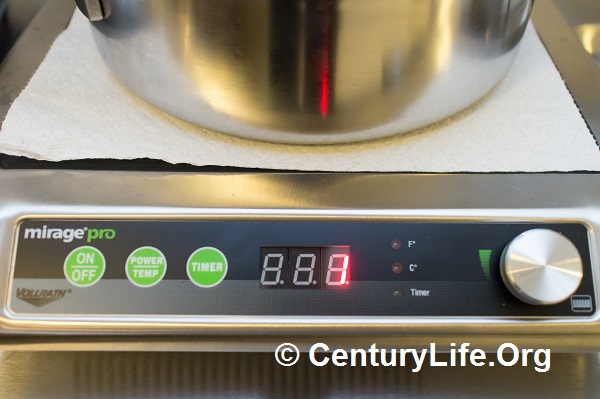
The front panel is covered by a tough membrane similar to what you find on Blendtec blenders or other foodservice appliances. I have no doubt that it will survive residential and commercial use.
The front panel is angled, unlike cheap portable induction units that look like flat tablets and as a result can have hot pan edges scorching the electronic control panel.
The dial feels like it’s made of metal, not plastic, and has indents so you feel each increment as you turn the dial. The air intake for the fan is at the front of the unit. Four stubby rubber-tipped legs keep the unit raised about half an inch (1.27 cm) off the countertop. The unit comes with a six-foot (1.83 meter) power cord with a three prong (grounded) plug at the end.
Inside, the unit has a coil roughly 8.3 inches across, including the hub, generating about a 4.3-inch diameter circular hotspot in the middle of the ceramic-covered cooking surface.1 This is a little larger than the typical 6- to 7-inch diameter coils you see on cheaper induction cookers that generate circular hotspots less than 4 inches in diameter. ~4.3 inches isn’t that much, so I would not use cookware with an exterior bottom diameter of more than ~10 inches with this cooker, give or take, depending on the quality of the cookware.2
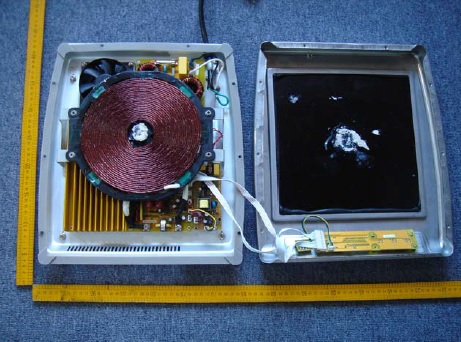
The headline feature of this unit is how it has 100 power settings–ten times as many as is typical among sub-$250 induction cookers. This is practically unheard of for portable induction units, and even in-counter (non-portable) induction units often have only 10 to 20 power settings.
Adjusting power level up or down manually is performed via a dial rather than with buttons, so in theory you can change the power level quickly. In practice, a typical (non-awkward) turn of the dial results in adding or subtracting ~20 power levels. So going from 1 to 100 or vice versa would take you about five turns of the dial. But if finer temperature control means I have to turn the dial more often, I can live with that. Besides, if you need to cool something down really quickly, you can turn the unit off, or lift the pan off the cooker by an inch or more, which should break the induction coupling until you set the pan on top of the Mirage Pro again.
The unit may also be programmed to target 80-400F (27-204C), as measured by a thermometer underneath the ceramic. The unit understands both Fahrenheit and Celsius and you can switch between them. (In the instruction manual, Vollrath says that if you use manual controls, i.e., 1-100, you can exceed 525F at power level 100. Apparently the maximum “target” temperature of 400F is there for safety purposes.)
In target-temperature mode, the target temperature increments 10 degrees at a time, and a typical spin of the dial is worth about 180 degrees F or C. (NOTE: There is some lag time between the pan and the thermometer that is underneath the ceramic, 30 seconds or more depending on the pan, so the induction unit tends to overshoot when pre-heating a pan before settling back down to the target temperature. This is typical of induction cooktops in general, and not just this unit. I recommend starting with a low manual power setting, and then once the ceramic has heated up a little bit, you can use the Mirage Pro’s target-temperature mode.)
Though there is some interpolation of power levels, it’s nowhere near as bad as on the cheapest induction cookers which have OMIGOSH HOT pulses for several seconds followed by several seconds of absolutely no heating at all. On this unit, the lowest power setting, 1, generates a split-second ~50 watt pulse of energy into the pan every ~3 seconds. This means you have very fine control over temperature. For instance, you could melt chocolate without scorching it or bring a soup to a precise simmer temperature. In contrast, those cheap portable induction units that swing back and forth from OMIGOSH HOT to zero-watts will burn food during those OMIGOSH HOT pulses. Similarly, the Mirage Pro can give you a controlled simmer instead of bouncing back and forth between boiling and sub-simmer temperatures, which is less than ideal; you can’t uncook over-cooked food.
A cool and rare feature of this induction cooker is how you can lift the pan off the ceramic for up to a minute before the cooker turns itself off. If you remove a pan, the front panel will flash “ADD PAN” for 60 seconds at which point it gives up waiting and shuts itself off. Most cheap induction burners give you more like 2 seconds instead of 60, making it hard to cook using saute or stir-fry motions (lifting and moving the pan on and off the ceramic).
Another feature of this unit is how it remembers the last temperature setting you used–regardless of how long ago you used it or even if you turn the unit off. If the unit gets unplugged, though, the memory goes with it, and it will default to power level 1 when next turned on.
The unit also has a built-in timer that can increment from 1 minute to 180 minutes, set in full-minute increments. The unit shuts itself off after the timer counts down to zero. (If you don’t use the timer, the unit will keep going until you turn it off.)
Noise levels are very well-controlled. Until the thermometer underneath the ceramic crosses a certain temperature, the fan is inaudible. After that temperature threshold, the fan spins faster and produces a louder whir. There are no whining/shrieking sounds that are common among cheap induction cookers. You can still hear a quiet buzz, and some cookware is louder than others (my Demeyere pans are relatively quiet, for instance), but it’s not a high-pitched, unpleasant squeal. I would recommend sliding a paper towel or 450F parchment paper underneath your cookware in order to further dampen the sound. (You could also use newspaper, but I’d rather not expose newspaper ink to high temperatures, just in case. A silicone baking mat
is also okay, but if you ever accidentally melt it, it may get messy to remove.)
The Vollrath 59500P Mirage Pro induction cooker has the usual array of safety features, including auto-shutoff in case of overheat/volt, as well as a grounded (three-prong) plug. This is industry standard, though, so it’s not something to be especially proud of.
However, the unit does have an unusual additional safety feature where the front panel will continuously flash “HOT PAN” until the thermometer detects safe levels of heat on the ceramic.
The unit does not emit any light when turned off and plugged in, unlike other units which have flashing lights (like a VCR that has not been set) even when turned off.
Here’s Vollrath’s video demonstrating how the Mirage Pro can melt chocolate without burning it (the video’s name is wrong; the video is about the Mirage Pro, not the lower-end Mirage Cadet, which has only 20 power levels and made with worse materials like plastic bottom and lower-end fan):
The Bad:
When the Vollrath Mirage Pro 59500P induction unit is plugged in and off, it still draws ~2 watts of power, which is twice as much as other induction cookers and appliances I’ve tested. This might be due to its memory feature where it remembers the last power level used so that when you turn it on again, it starts at that power level instead of power level 1. But to place things into context, one watt is negligible and would cost the typical U.S. household less than a dollar per year. Over the course of the year, you’re likely to save more than a dollar by switching to induction from gas or electric coil.
The coil could stand to be bigger like higher-end non-portable induction cooktops, but the coil is still significantly larger in diameter (~8.3 inches) than some cheaper induction cookers (6-7 inches diameter).
Also, I am not sure but I suspect the fans aren’t as good as they could be. For home use, it should be fine; I estimate that the unit will last 55 years for residential home use even if you use the cooker every day for two hours a day.3 The Mirage pro may not last as long in a busy commercial kitchen, depending on exactly how dirty/hot/greasy/etc. the restaurant is and how many hours a day the unit has to operate. Still, Vollrath must have some faith in the Mirage Pro’s ability to withstand high-volume restaurant torture, because the Mirage Pro has a 2-year warranty instead of a 6-month or 1-year warranty like typical “commercial” induction cookers that are actually consumer induction cookers with metal exteriors instead of plastic exteriors. You void the warranty if you open the Mirage Pro case, but that’s standard for the industry.
The Weird:
1. Automatic voltage regulation means that more-efficient cookware can get throttled down.
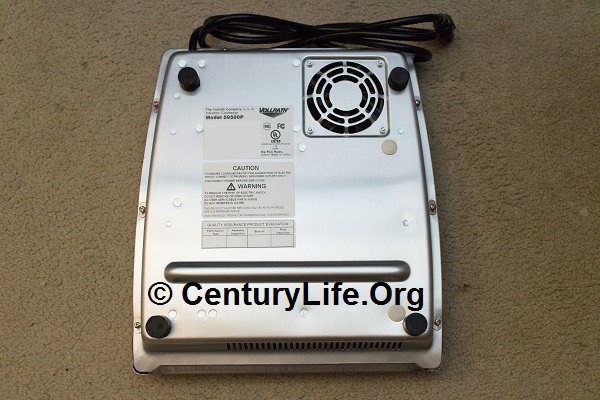
The clearest example I can give is how Demeyere Proline skillets are more efficient on induction than even cast iron, by roughly 10%. (The Demeyere company claims its Proline skillets are up to 30% more efficient on induction than rivals, but other than a few exceptions, it’s more like 10%.) Demeyere Proline is practically unique in this respect. Even other Demeyere cookware aren’t as efficient as Proline.
Because Demeyere Proline is more efficient than normal, if you try to crank the Mirage Pro unit past Power Level 90 with a Proline pan, wattage actually starts to drop. Presumably what’s happening is that the abnormally-efficient Proline crosses a predetermined “safe” voltage level threshold, and the induction cooker responds by dropping electric current. The result is that at power level 100, the maximum wattage I can get out of my Proline pans is 100 watts LESS than my other pans. No other induction cooker I’ve tried has this feature; usually the Proline draws as much as 150 watts more… for a few glorious moments until the induction cooker panics and reacts to the overvoltage by shutting down.
In practice, Vollrath’s throttling doesn’t really affect anything other than Proline pans, and even there you can simply heat at power level 90 instead of 100, so I’m just mentioning this oddity for those who are curious. You should probably never use maximum heat except when boiling water, anyway. And I’d rather have the cooker throttle down than have it turn itself off in the middle of cooking.
So there you have it: it’s a feature, not a bug.
But wait, it gets better!
2. Unlike every other induction cooker I’ve ever tried, the Mirage Pro dynamically scales with pan diameter. With most induction cookers, if the diameter of a pan isn’t large enough to soak up the induction energy, then you get less wattage. For instance, if you set a cooker to max power, it might deliver 1700 watts to a 9-inch diameter pan but only 1000 watts to a 6-inch diameter pan.
Not so with this Mirage Pro! The unit is able to compensate–up to a point. I first noticed this effect when I was going through pan testing and found that no matter how small the diameter of the pan I used, a given power level always delivered roughly the same wattage.
Why does this happen? Perhaps because this particular induction cooker doesn’t rely on “dumb” electronics like most portable induction cookers. The Mirage Pro has sophisticated, “smart” electronics and therefore targets a certain wattage level for any given power setting. And it’s accurate.
However, there are limits. I tried heating a magnetic stainless bowl with a 3.5-inch flat base. It drew ~800 watts at power level 49 like every other pan, but even when I cranked up the power level to maximum (100), the unit could not get past 1050 watts. There was not enough surface area to get that strong of an induction link. But even 1050 watts is a LOT for such a small-diameter pan, so it’s not a real issue in actual usage. And it’s a lot better than “dumber” induction cookers which would either deliver a small fraction of 1050 watts or shut down altogether.
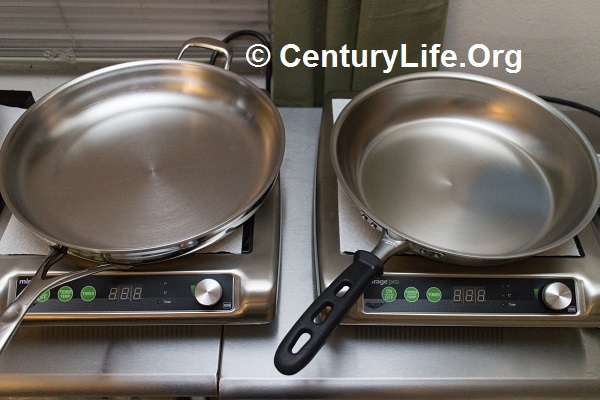
Conclusion:
This Vollrath Mirage Pro 59500P induction range completely outclasses every other portable induction cooker on the market under $1000 that runs on 120-volt (regular power outlet).4
Basically, the Vollrath Mirage Pro 59500P sits at the sweet spot between performance/reliability and affordability. There’s a huge dropoff if you go cheaper, and you gain almost nothing if you pay more:
- Compared to less-expensive induction cookers, the Mirage Pro is better built, is quieter, has a larger induction coil, and gives you 100 power levels–which is 80 more power levels than some NON-portable induction cooktops, and 90+ more power levels than most portable induction cookers. Unlike most portable induction cookers, the Mirage Pro gives you the same wattage regardless of pan diameter (within reason), the unit won’t immediately shut down if you lift the pan (e.g., to saute), and the unit automatically throttles under overvoltage conditions, rather than simply shutting down.
-

Cooktek Apogee MC1800G The only other portable induction cooker on the market with 100 power levels is the $1000 Cook-Tek Apogee MC1800G 120V, which has a hotspot about 0.6 centimeters larger in diameter than the Mirage Pro, plus a somewhat more rugged build quality (has a grease filter over its fan intake). (Its ancestor, the Cook-Tek MC1800, has only 20 power settings, lacks a timer, and costs over $800 including shipping, so I don’t recommend it.)
- However, the MC1800/MC1800G has clumsy electronics that a) do not account for cookware diameter and b) freak out about overvoltage. I can get only ~1300 watts out of my cookware with ~6 inch bottom diameters. In contrast, the Vollrath Mirage Pro 59500P can maintain maximum wattage down to very small diameters (less than 5 inches) for faster boiling of small-diameter pots and pans. And if there’s too much voltage, the Cook-Tek will shut down, whereas the Vollrath will simply throttle down to protect itself.
- Also, the MC1800G’s touchscreen menus are harder to use than the Vollrath’s dials. You need to do a lot more pressing and menu-diving to do simple things like setting the timer. You would think that hitting the MC1800G’s timer button would take you to a minute counter, but instead you have to press “down” and then set the minutes and then approve the timer. The Vollrath is easier to use: hit the timer button and turn the dial to tell it how many minutes you want it to go. That’s it! No extra steps.
- Therefore, assuming your kitchen isn’t so hellishly greasy and dirty that you need a fan grease filter, there is no reason to get the Cook-Tek units that cost almost twice as much as the Mirage Pro.
Why doesn’t any company other than Vollrath (and Cook-Tek, which is also an American company) offer smart induction cookers? I’m guess it’s because they can’t. Most companies selling portable induction cookers in North America are merely importers; they basically ask a Chinese factory that makes induction cookers intended for the Asian market to adapt the design to the North American market and to slap the importer’s logo on it. The result is a cheap induction cooker with lower-spec features (e.g., fewer power level settings) and questionable longevity.
In contrast, Vollrath is an American company that owns everything from start to finish: patents, designs, and factory. Vollrath custom-designed and custom-manufactured the Mirage Pro 59500P induction unit to its own specifications, rather than importing whatever happened to be available in the Chinese market.
The Mirage Pro is the way induction is meant to be: fine-grained, repeatable, responsive controls for repeatable results, and with the option of cranking up the power to boil water quickly. High-end induction is the electrical equivalent of cooking with gas, but with easy clean-up, no gas combustion byproducts to vent (some of which builds up as black stuff on the bottom of your pans), and much less waste heat, which is very welcome during summertime. Highly recommended.